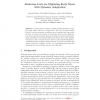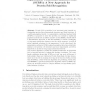431 search results - page 74 / 87 » Factorial Hidden Markov Models for Gait Recognition |
ICPR
2006
IEEE
14 years 8 months ago
2006
IEEE
Coarticulation is one of the important factors that makes automatic sign language recognition a hard problem. Unlike in speech recognition, coarticulation effects in sign language...
ICDAR
2003
IEEE
14 years 27 days ago
2003
IEEE
This paper aims at automatic recognition of online handwritten mathematical expressions written on an electronic tablet. The proposed technique involves two major stages: symbol r...
LREC
2010
13 years 9 months ago
2010
Current state-of-the-art systems for automatic phonetic transcription (APT) are mostly phone recognizers based on Hidden Markov models (HMMs). We present a different approach for ...
ERCIMDL
2007
Springer
14 years 1 months ago
2007
Springer
Abstract. Optical music recognition (OMR) enables librarians to digitise early music sources on a large scale. The cost of expert human labour to correct automatic recognition erro...
RECOMB
2005
Springer
14 years 8 months ago
2005
Springer
Abstract. Protein fold recognition is an important step towards understanding protein three-dimensional structures and their functions. A conditional graphical model, i.e. segmenta...


